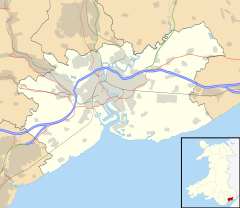Rogerstone
| Rogerstone | |
|---|---|
| Rogerstone shown within Newport | |
| Population | 10,158 (2011 census) |
| OS grid reference | ST271885 |
| Principal area | |
| Country | Wales |
| Sovereign state | United Kingdom |
| Post town | NEWPORT |
| Postcode district | NP10 |
| Dialling code | 01633 |
| Police | Gwent |
| Fire | South Wales |
| Ambulance | Welsh |
| EU Parliament | Wales |
| UK Parliament | |
Rogerstone (Welsh: Tŷ du, meaning "Black house") is a village, ward and community (parish) of the city of Newport, southeastern Wales. The area is governed by the Newport City Council. The village falls within the ancient parish of Bassaleg and historic county of Monmouthshire.
The parish lies at the gateway to the Sirhowy valley, to the north of Newport on the eastern side of the Ebbw River. It is bounded by the M4 motorway to the south, the Ebbw River to the west, the Henllys vale to the east and the city boundary with Caerphilly county borough to the north.
Rogerstone railway station is on the Ebbw Valley Railway. It opened on 6 February 2008 and links Ebbw Vale to Cardiff Central via Rogerstone.
The original settlement dates back to Norman times when Rogerstone Castle was built in the early part of the 12th century. The name is said to originate from Roger de Haia, the Norman Lord who was responsible for the building of the castle, the remains of which are reduced to a low bush and tree covered motte opposite Criddle's garage on the lower section of Tregwilym Road. The Welsh name for Rogerstone "Tŷ Du" translates to English as "Black House", though no one is entirely sure why it has this name.
The larger parish of Rogerstone started as two distinct settlements of Tregwilym and Tydu, Tregwilym taking its name from the land owner, William de Berkerolles. These hamlets remained predominantly rural until the advent of the industrial revolution. The population grew in response to the tin, iron and aluminium industries which flourished near the South Wales coalfield. At one point, the village boasted the longest aluminium rolling mill in Western Europe and one of the largest marshalling yards on the Great Western Railway network.
...
Wikipedia

